Professional Employability Plan: Engineering Recruitment & Networking
VerifiedAdded on 2022/09/18
|11
|2659
|27
Report
AI Summary
This report presents a comprehensive professional employability plan tailored for engineering students, focusing on the Australian engineering industry. It begins with an analysis of current recruitment practices, including trends such as the increasing demand for experienced engineers, the use of technology in recruitment, outsourcing and insourcing strategies, a preference for local experience, employer branding, and the importance of hiring interns. The report then explores the crucial role of networking in the engineering industry, highlighting its impact on professional growth, opportunities, and resource acquisition. The plan outlines short, medium, and long-term career goals, emphasizing the importance of skill development and self-reflection. It details the required skills, strengths, and development needs, along with a SMART goal-setting approach to ensure the achievability of career objectives. The report also includes an action plan for skill development, with specific activities and timelines for personal and professional growth, making it a valuable resource for engineering students aiming to enhance their employability.

Running Head: PROFESSIONAL EMPLOYABILITY PLAN
Professional Employability Plan
Name
Institution
Professional Employability Plan
Name
Institution
Paraphrase This Document
Need a fresh take? Get an instant paraphrase of this document with our AI Paraphraser
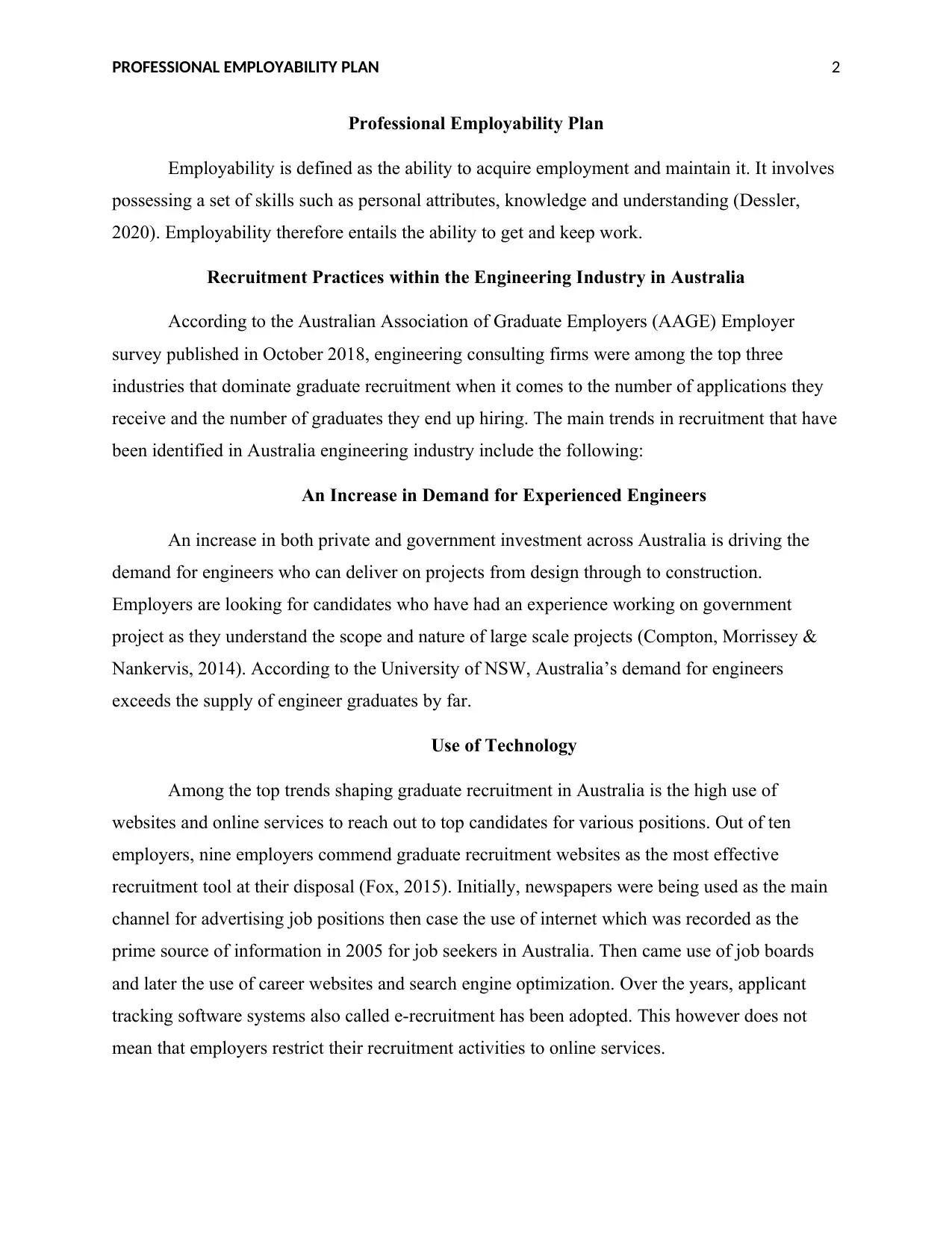
PROFESSIONAL EMPLOYABILITY PLAN 2
Professional Employability Plan
Employability is defined as the ability to acquire employment and maintain it. It involves
possessing a set of skills such as personal attributes, knowledge and understanding (Dessler,
2020). Employability therefore entails the ability to get and keep work.
Recruitment Practices within the Engineering Industry in Australia
According to the Australian Association of Graduate Employers (AAGE) Employer
survey published in October 2018, engineering consulting firms were among the top three
industries that dominate graduate recruitment when it comes to the number of applications they
receive and the number of graduates they end up hiring. The main trends in recruitment that have
been identified in Australia engineering industry include the following:
An Increase in Demand for Experienced Engineers
An increase in both private and government investment across Australia is driving the
demand for engineers who can deliver on projects from design through to construction.
Employers are looking for candidates who have had an experience working on government
project as they understand the scope and nature of large scale projects (Compton, Morrissey &
Nankervis, 2014). According to the University of NSW, Australia’s demand for engineers
exceeds the supply of engineer graduates by far.
Use of Technology
Among the top trends shaping graduate recruitment in Australia is the high use of
websites and online services to reach out to top candidates for various positions. Out of ten
employers, nine employers commend graduate recruitment websites as the most effective
recruitment tool at their disposal (Fox, 2015). Initially, newspapers were being used as the main
channel for advertising job positions then case the use of internet which was recorded as the
prime source of information in 2005 for job seekers in Australia. Then came use of job boards
and later the use of career websites and search engine optimization. Over the years, applicant
tracking software systems also called e-recruitment has been adopted. This however does not
mean that employers restrict their recruitment activities to online services.
Professional Employability Plan
Employability is defined as the ability to acquire employment and maintain it. It involves
possessing a set of skills such as personal attributes, knowledge and understanding (Dessler,
2020). Employability therefore entails the ability to get and keep work.
Recruitment Practices within the Engineering Industry in Australia
According to the Australian Association of Graduate Employers (AAGE) Employer
survey published in October 2018, engineering consulting firms were among the top three
industries that dominate graduate recruitment when it comes to the number of applications they
receive and the number of graduates they end up hiring. The main trends in recruitment that have
been identified in Australia engineering industry include the following:
An Increase in Demand for Experienced Engineers
An increase in both private and government investment across Australia is driving the
demand for engineers who can deliver on projects from design through to construction.
Employers are looking for candidates who have had an experience working on government
project as they understand the scope and nature of large scale projects (Compton, Morrissey &
Nankervis, 2014). According to the University of NSW, Australia’s demand for engineers
exceeds the supply of engineer graduates by far.
Use of Technology
Among the top trends shaping graduate recruitment in Australia is the high use of
websites and online services to reach out to top candidates for various positions. Out of ten
employers, nine employers commend graduate recruitment websites as the most effective
recruitment tool at their disposal (Fox, 2015). Initially, newspapers were being used as the main
channel for advertising job positions then case the use of internet which was recorded as the
prime source of information in 2005 for job seekers in Australia. Then came use of job boards
and later the use of career websites and search engine optimization. Over the years, applicant
tracking software systems also called e-recruitment has been adopted. This however does not
mean that employers restrict their recruitment activities to online services.
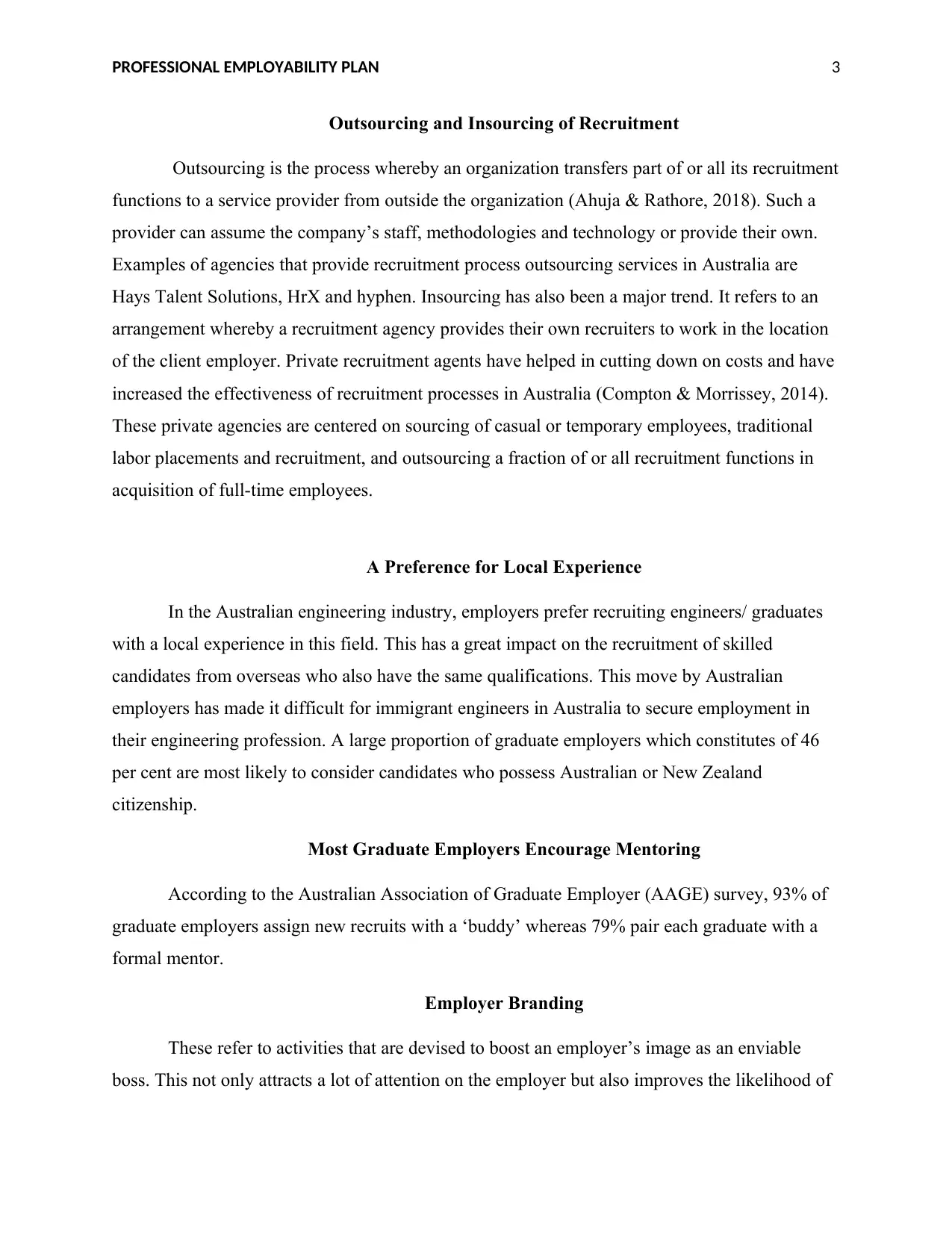
PROFESSIONAL EMPLOYABILITY PLAN 3
Outsourcing and Insourcing of Recruitment
Outsourcing is the process whereby an organization transfers part of or all its recruitment
functions to a service provider from outside the organization (Ahuja & Rathore, 2018). Such a
provider can assume the company’s staff, methodologies and technology or provide their own.
Examples of agencies that provide recruitment process outsourcing services in Australia are
Hays Talent Solutions, HrX and hyphen. Insourcing has also been a major trend. It refers to an
arrangement whereby a recruitment agency provides their own recruiters to work in the location
of the client employer. Private recruitment agents have helped in cutting down on costs and have
increased the effectiveness of recruitment processes in Australia (Compton & Morrissey, 2014).
These private agencies are centered on sourcing of casual or temporary employees, traditional
labor placements and recruitment, and outsourcing a fraction of or all recruitment functions in
acquisition of full-time employees.
A Preference for Local Experience
In the Australian engineering industry, employers prefer recruiting engineers/ graduates
with a local experience in this field. This has a great impact on the recruitment of skilled
candidates from overseas who also have the same qualifications. This move by Australian
employers has made it difficult for immigrant engineers in Australia to secure employment in
their engineering profession. A large proportion of graduate employers which constitutes of 46
per cent are most likely to consider candidates who possess Australian or New Zealand
citizenship.
Most Graduate Employers Encourage Mentoring
According to the Australian Association of Graduate Employer (AAGE) survey, 93% of
graduate employers assign new recruits with a ‘buddy’ whereas 79% pair each graduate with a
formal mentor.
Employer Branding
These refer to activities that are devised to boost an employer’s image as an enviable
boss. This not only attracts a lot of attention on the employer but also improves the likelihood of
Outsourcing and Insourcing of Recruitment
Outsourcing is the process whereby an organization transfers part of or all its recruitment
functions to a service provider from outside the organization (Ahuja & Rathore, 2018). Such a
provider can assume the company’s staff, methodologies and technology or provide their own.
Examples of agencies that provide recruitment process outsourcing services in Australia are
Hays Talent Solutions, HrX and hyphen. Insourcing has also been a major trend. It refers to an
arrangement whereby a recruitment agency provides their own recruiters to work in the location
of the client employer. Private recruitment agents have helped in cutting down on costs and have
increased the effectiveness of recruitment processes in Australia (Compton & Morrissey, 2014).
These private agencies are centered on sourcing of casual or temporary employees, traditional
labor placements and recruitment, and outsourcing a fraction of or all recruitment functions in
acquisition of full-time employees.
A Preference for Local Experience
In the Australian engineering industry, employers prefer recruiting engineers/ graduates
with a local experience in this field. This has a great impact on the recruitment of skilled
candidates from overseas who also have the same qualifications. This move by Australian
employers has made it difficult for immigrant engineers in Australia to secure employment in
their engineering profession. A large proportion of graduate employers which constitutes of 46
per cent are most likely to consider candidates who possess Australian or New Zealand
citizenship.
Most Graduate Employers Encourage Mentoring
According to the Australian Association of Graduate Employer (AAGE) survey, 93% of
graduate employers assign new recruits with a ‘buddy’ whereas 79% pair each graduate with a
formal mentor.
Employer Branding
These refer to activities that are devised to boost an employer’s image as an enviable
boss. This not only attracts a lot of attention on the employer but also improves the likelihood of
⊘ This is a preview!⊘
Do you want full access?
Subscribe today to unlock all pages.

Trusted by 1+ million students worldwide

PROFESSIONAL EMPLOYABILITY PLAN 4
attracting applicants/ candidates of desired quality and having such candidates accept their job
offers (Crowleys Ridge Technical Institute, 2015). This process highly uses social media to
engage jobseekers directly for example, Glassdoor. Employer branding helps to increase the
quantity and quality of job applicants.
Hiring Interns
Most employers in Australia prefer hiring back interns who had previously worked in
their companies as they have acquired relevant skills and experience which is useful in the
companies. For example, an engineering intern is hired by the same company they did their
internship after completing their course. This saves on recruitment costs that would have
otherwise been used to acquire new employees.
Role of Networking in the Engineering Industry in Australia
Many professionals tend to believe that networking is all about following experts in their
industries on their social media platforms. This however is not beneficial to them but to these
already famous people with big names. Any individual professional with the zeal to use their
network as a ladder up the systems and spark new ideas should however start with the people
close to them such as colleagues and other acquaintances in the industry (Sandberg, 2015). A
widespread and strong professional network creates awareness on trends and information from
people in the know on job openings within an organization.
Networking is as important to engineers as it is to other professionals (Fasano, 2015). The
importance of networking to engineering professionals can be summarized as below:
Professional Growth
A well-maintained network can help with professional growth which is key to having a
lustrous career. The people one interacts with provide an outlet for learning new skills (Smale &
Fowlie, 2015). Acquiring new skills will most likely help reach new heights in one’s career.
Guidance
Guidance is very important whether one is a budding developer or a veteran engineer.
Building and maintaining a strong network helps one to grow their knowledge, align with
individuals with more knowledge and experience and become more ingrained in the industry.
attracting applicants/ candidates of desired quality and having such candidates accept their job
offers (Crowleys Ridge Technical Institute, 2015). This process highly uses social media to
engage jobseekers directly for example, Glassdoor. Employer branding helps to increase the
quantity and quality of job applicants.
Hiring Interns
Most employers in Australia prefer hiring back interns who had previously worked in
their companies as they have acquired relevant skills and experience which is useful in the
companies. For example, an engineering intern is hired by the same company they did their
internship after completing their course. This saves on recruitment costs that would have
otherwise been used to acquire new employees.
Role of Networking in the Engineering Industry in Australia
Many professionals tend to believe that networking is all about following experts in their
industries on their social media platforms. This however is not beneficial to them but to these
already famous people with big names. Any individual professional with the zeal to use their
network as a ladder up the systems and spark new ideas should however start with the people
close to them such as colleagues and other acquaintances in the industry (Sandberg, 2015). A
widespread and strong professional network creates awareness on trends and information from
people in the know on job openings within an organization.
Networking is as important to engineers as it is to other professionals (Fasano, 2015). The
importance of networking to engineering professionals can be summarized as below:
Professional Growth
A well-maintained network can help with professional growth which is key to having a
lustrous career. The people one interacts with provide an outlet for learning new skills (Smale &
Fowlie, 2015). Acquiring new skills will most likely help reach new heights in one’s career.
Guidance
Guidance is very important whether one is a budding developer or a veteran engineer.
Building and maintaining a strong network helps one to grow their knowledge, align with
individuals with more knowledge and experience and become more ingrained in the industry.
Paraphrase This Document
Need a fresh take? Get an instant paraphrase of this document with our AI Paraphraser
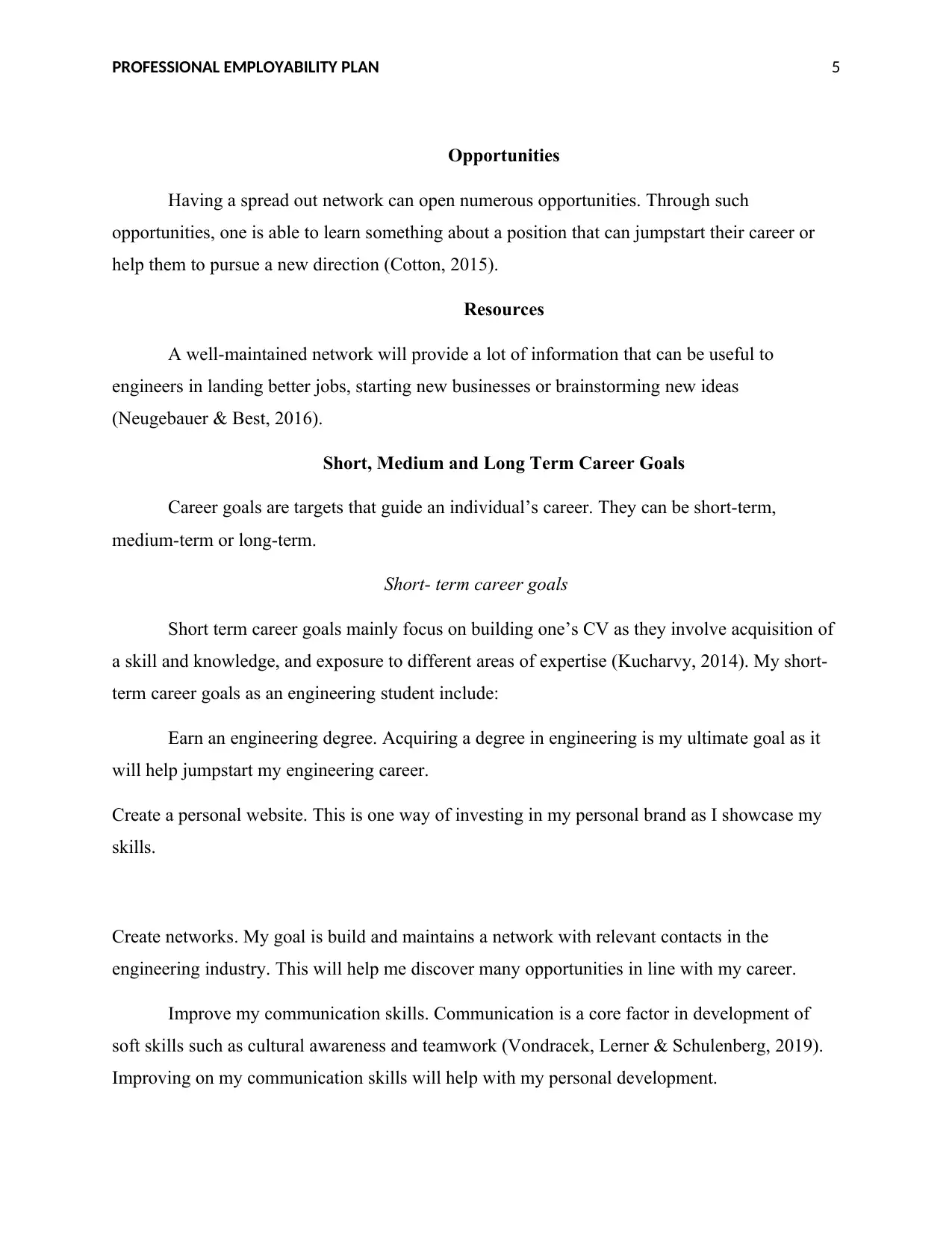
PROFESSIONAL EMPLOYABILITY PLAN 5
Opportunities
Having a spread out network can open numerous opportunities. Through such
opportunities, one is able to learn something about a position that can jumpstart their career or
help them to pursue a new direction (Cotton, 2015).
Resources
A well-maintained network will provide a lot of information that can be useful to
engineers in landing better jobs, starting new businesses or brainstorming new ideas
(Neugebauer & Best, 2016).
Short, Medium and Long Term Career Goals
Career goals are targets that guide an individual’s career. They can be short-term,
medium-term or long-term.
Short- term career goals
Short term career goals mainly focus on building one’s CV as they involve acquisition of
a skill and knowledge, and exposure to different areas of expertise (Kucharvy, 2014). My short-
term career goals as an engineering student include:
Earn an engineering degree. Acquiring a degree in engineering is my ultimate goal as it
will help jumpstart my engineering career.
Create a personal website. This is one way of investing in my personal brand as I showcase my
skills.
Create networks. My goal is build and maintains a network with relevant contacts in the
engineering industry. This will help me discover many opportunities in line with my career.
Improve my communication skills. Communication is a core factor in development of
soft skills such as cultural awareness and teamwork (Vondracek, Lerner & Schulenberg, 2019).
Improving on my communication skills will help with my personal development.
Opportunities
Having a spread out network can open numerous opportunities. Through such
opportunities, one is able to learn something about a position that can jumpstart their career or
help them to pursue a new direction (Cotton, 2015).
Resources
A well-maintained network will provide a lot of information that can be useful to
engineers in landing better jobs, starting new businesses or brainstorming new ideas
(Neugebauer & Best, 2016).
Short, Medium and Long Term Career Goals
Career goals are targets that guide an individual’s career. They can be short-term,
medium-term or long-term.
Short- term career goals
Short term career goals mainly focus on building one’s CV as they involve acquisition of
a skill and knowledge, and exposure to different areas of expertise (Kucharvy, 2014). My short-
term career goals as an engineering student include:
Earn an engineering degree. Acquiring a degree in engineering is my ultimate goal as it
will help jumpstart my engineering career.
Create a personal website. This is one way of investing in my personal brand as I showcase my
skills.
Create networks. My goal is build and maintains a network with relevant contacts in the
engineering industry. This will help me discover many opportunities in line with my career.
Improve my communication skills. Communication is a core factor in development of
soft skills such as cultural awareness and teamwork (Vondracek, Lerner & Schulenberg, 2019).
Improving on my communication skills will help with my personal development.
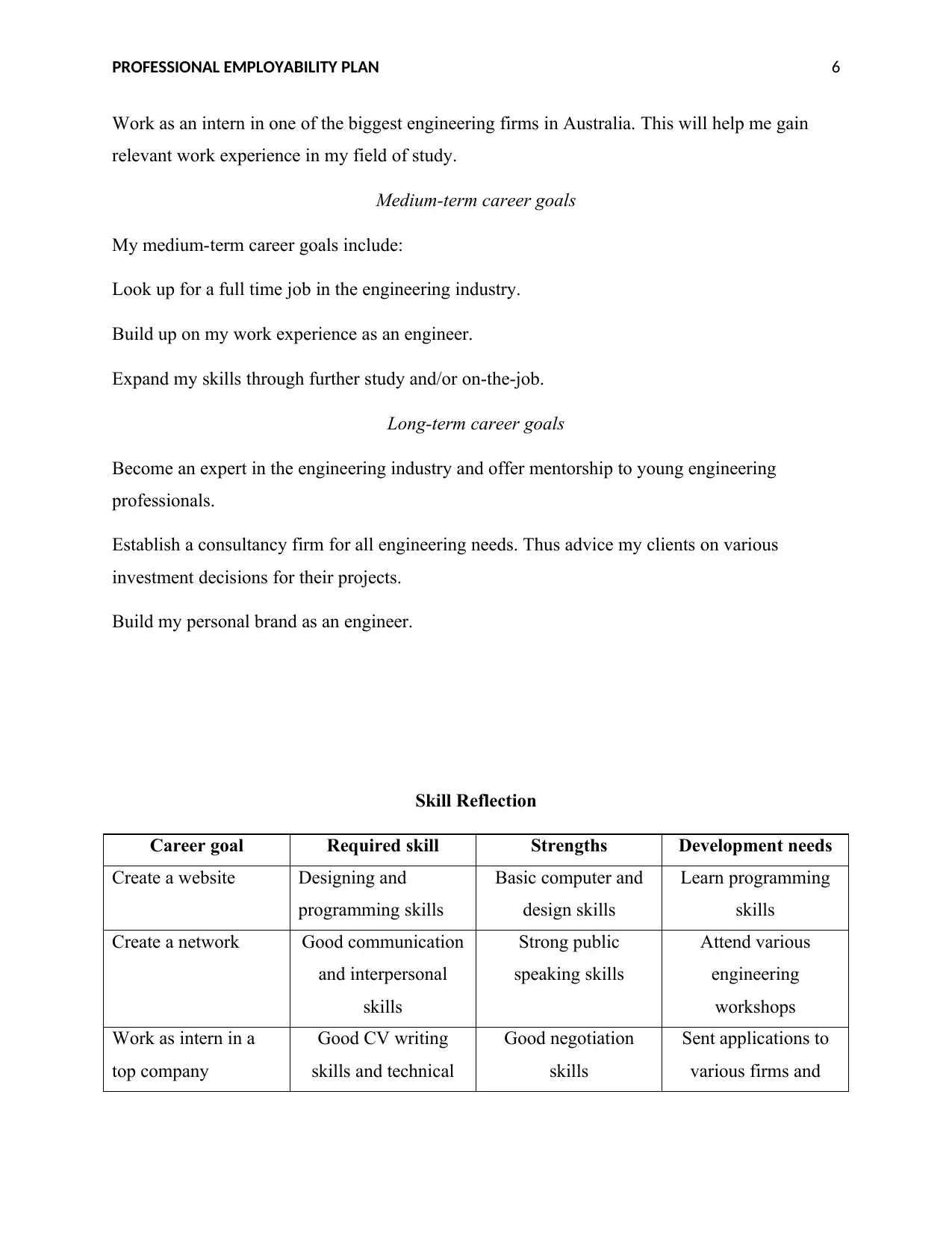
PROFESSIONAL EMPLOYABILITY PLAN 6
Work as an intern in one of the biggest engineering firms in Australia. This will help me gain
relevant work experience in my field of study.
Medium-term career goals
My medium-term career goals include:
Look up for a full time job in the engineering industry.
Build up on my work experience as an engineer.
Expand my skills through further study and/or on-the-job.
Long-term career goals
Become an expert in the engineering industry and offer mentorship to young engineering
professionals.
Establish a consultancy firm for all engineering needs. Thus advice my clients on various
investment decisions for their projects.
Build my personal brand as an engineer.
Skill Reflection
Career goal Required skill Strengths Development needs
Create a website Designing and
programming skills
Basic computer and
design skills
Learn programming
skills
Create a network Good communication
and interpersonal
skills
Strong public
speaking skills
Attend various
engineering
workshops
Work as intern in a
top company
Good CV writing
skills and technical
Good negotiation
skills
Sent applications to
various firms and
Work as an intern in one of the biggest engineering firms in Australia. This will help me gain
relevant work experience in my field of study.
Medium-term career goals
My medium-term career goals include:
Look up for a full time job in the engineering industry.
Build up on my work experience as an engineer.
Expand my skills through further study and/or on-the-job.
Long-term career goals
Become an expert in the engineering industry and offer mentorship to young engineering
professionals.
Establish a consultancy firm for all engineering needs. Thus advice my clients on various
investment decisions for their projects.
Build my personal brand as an engineer.
Skill Reflection
Career goal Required skill Strengths Development needs
Create a website Designing and
programming skills
Basic computer and
design skills
Learn programming
skills
Create a network Good communication
and interpersonal
skills
Strong public
speaking skills
Attend various
engineering
workshops
Work as intern in a
top company
Good CV writing
skills and technical
Good negotiation
skills
Sent applications to
various firms and
⊘ This is a preview!⊘
Do you want full access?
Subscribe today to unlock all pages.

Trusted by 1+ million students worldwide

PROFESSIONAL EMPLOYABILITY PLAN 7
skills volunteer
In order to accomplish my short-term career goals, acquiring and applying the following skills is
necessary.
Negotiation skills
Problem solving and conflict resolution skills
Public speaking skills
Good writing skills
All the above skills are key in personal development which helps achieve goals and develop
professionally.
Strengths and Development Needs
Strengths action plan
Development
activity
where When Measure capture Progress
tracking
Project Construction site During the
holidays
Ensured that I
followed the
supervisor’s
instructions
Did well
Workshop Engineering firm During the
semester
Exercised
teamwork
Did well
Personal development entails identifying and acknowledging one’s strengths and
weaknesses. To ensure growth, an individual ought to master their strengths and work on their
weaknesses according to their development needs (Fowlie, 2015). I have set my career goals
based on my strengths as an individual which include:
Creativity and innovation- A competent engineer should always be creative to come up with
ways of improving the existing systems or even innovating new ones.
skills volunteer
In order to accomplish my short-term career goals, acquiring and applying the following skills is
necessary.
Negotiation skills
Problem solving and conflict resolution skills
Public speaking skills
Good writing skills
All the above skills are key in personal development which helps achieve goals and develop
professionally.
Strengths and Development Needs
Strengths action plan
Development
activity
where When Measure capture Progress
tracking
Project Construction site During the
holidays
Ensured that I
followed the
supervisor’s
instructions
Did well
Workshop Engineering firm During the
semester
Exercised
teamwork
Did well
Personal development entails identifying and acknowledging one’s strengths and
weaknesses. To ensure growth, an individual ought to master their strengths and work on their
weaknesses according to their development needs (Fowlie, 2015). I have set my career goals
based on my strengths as an individual which include:
Creativity and innovation- A competent engineer should always be creative to come up with
ways of improving the existing systems or even innovating new ones.
Paraphrase This Document
Need a fresh take? Get an instant paraphrase of this document with our AI Paraphraser

PROFESSIONAL EMPLOYABILITY PLAN 8
Problem solving skills- This will help me address issues that may arise in the midst of my
projects.
Curiosity-This is a key trait for any successful engineering. Curiosity will help me land on new
opportunities and learn new things in line with my career path.
Attention to detail- Pay attention to even finer details of any work is a crucial skill for
any engineer because omission of any small aspect can cause great harm (Emden&
Becker, 2018).
Logical thinking and reasoning- An engineer that is great at what they do should be able
to understand complex systems, the way they work, how problems arise and how to fix
them.
Math skills- Engineering is a science that involves complex mathematics and excellent
understanding of the same is critical developing a good career.
Team player- Being a great team player will help me achieve success in my projects.
Communication skills- Besides understanding the technical complexities involved in their work,
engineers ought to be in a position to interpret such information to a layman such as clients and
workers.
Building on one’s self which refers to personal development plays an important role in
growing their career as it helps in making informed decisions and also opens opportunities to
learn and expand their career ambitions (Kerr & Power, 2016).
Weaknesses Action Plan
Development
activity
where When Measure Capture Progress
tracking
Attachment Engineering
consultancy
During
holidays
Followed
supervisor’s
instructions
Failed in
writing a
good report
Training At the
university
During the
semester
Wrote down
important
notes
Failed to
complete the
training
Problem solving skills- This will help me address issues that may arise in the midst of my
projects.
Curiosity-This is a key trait for any successful engineering. Curiosity will help me land on new
opportunities and learn new things in line with my career path.
Attention to detail- Pay attention to even finer details of any work is a crucial skill for
any engineer because omission of any small aspect can cause great harm (Emden&
Becker, 2018).
Logical thinking and reasoning- An engineer that is great at what they do should be able
to understand complex systems, the way they work, how problems arise and how to fix
them.
Math skills- Engineering is a science that involves complex mathematics and excellent
understanding of the same is critical developing a good career.
Team player- Being a great team player will help me achieve success in my projects.
Communication skills- Besides understanding the technical complexities involved in their work,
engineers ought to be in a position to interpret such information to a layman such as clients and
workers.
Building on one’s self which refers to personal development plays an important role in
growing their career as it helps in making informed decisions and also opens opportunities to
learn and expand their career ambitions (Kerr & Power, 2016).
Weaknesses Action Plan
Development
activity
where When Measure Capture Progress
tracking
Attachment Engineering
consultancy
During
holidays
Followed
supervisor’s
instructions
Failed in
writing a
good report
Training At the
university
During the
semester
Wrote down
important
notes
Failed to
complete the
training

PROFESSIONAL EMPLOYABILITY PLAN 9
SMART Goal Setting
Career goals set whether short, medium and long-term should be SMART.
S- Specific. Any career goal should be specific, that is, well-defined. A specific/ well-defined
goal is easier to achieve. For example, the goal could be to gain experience in the industry so as
to become a consultant engineer is specific as it requires no more explanation. Some of the
questions to ask is what is it that I want to achieve? What is the importance of this goal?
M-Measurable. A measurable goal is a goal that you can track your progress thus staying
focused. A measurable goal should be quantifiable for example, how much? How many?
A-Achievable. A goal should be attainable and should provide answer to questions like: how
will I attain this goal?
R-Realistic. A realistic goal is reasonable and can be attained using the resources available.
T-Time-bound. A good goal should be set within a given time limit that is, a deadline to work
towards. The goal should answer the following questions: when? What do I do five weeks from
today?
SMART is a tool that ensures clear goal setting, motivation and focus to attain set goals (Sarsby,
2016). This tool helps in improving the ability to achieve set goals by motivating individuals to
have well-defined objectives and have deadlines for themselves (Compton, Morrissey &
Nankervis, 2014).
SMART Goal Setting
Career goals set whether short, medium and long-term should be SMART.
S- Specific. Any career goal should be specific, that is, well-defined. A specific/ well-defined
goal is easier to achieve. For example, the goal could be to gain experience in the industry so as
to become a consultant engineer is specific as it requires no more explanation. Some of the
questions to ask is what is it that I want to achieve? What is the importance of this goal?
M-Measurable. A measurable goal is a goal that you can track your progress thus staying
focused. A measurable goal should be quantifiable for example, how much? How many?
A-Achievable. A goal should be attainable and should provide answer to questions like: how
will I attain this goal?
R-Realistic. A realistic goal is reasonable and can be attained using the resources available.
T-Time-bound. A good goal should be set within a given time limit that is, a deadline to work
towards. The goal should answer the following questions: when? What do I do five weeks from
today?
SMART is a tool that ensures clear goal setting, motivation and focus to attain set goals (Sarsby,
2016). This tool helps in improving the ability to achieve set goals by motivating individuals to
have well-defined objectives and have deadlines for themselves (Compton, Morrissey &
Nankervis, 2014).
⊘ This is a preview!⊘
Do you want full access?
Subscribe today to unlock all pages.

Trusted by 1+ million students worldwide
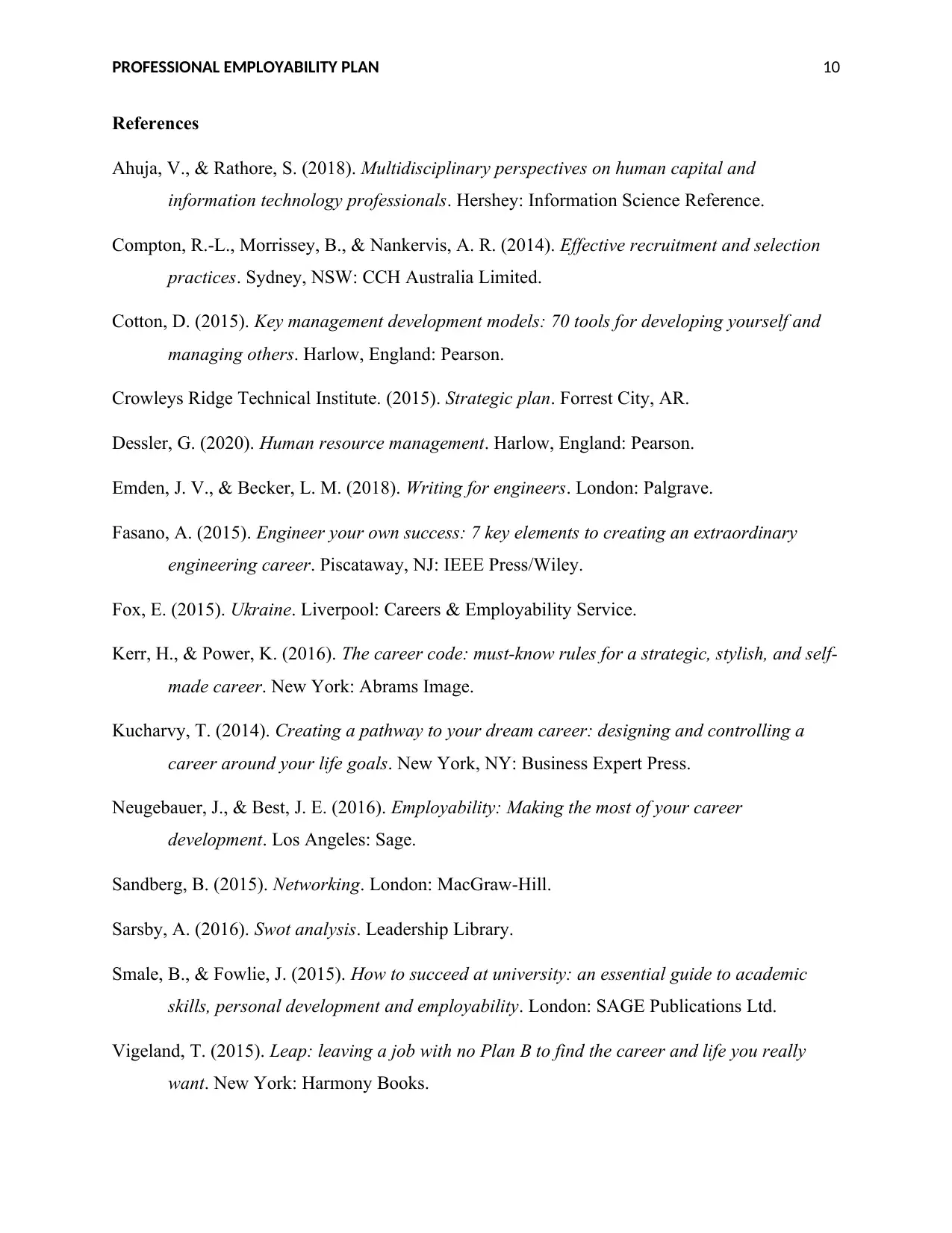
PROFESSIONAL EMPLOYABILITY PLAN 10
References
Ahuja, V., & Rathore, S. (2018). Multidisciplinary perspectives on human capital and
information technology professionals. Hershey: Information Science Reference.
Compton, R.-L., Morrissey, B., & Nankervis, A. R. (2014). Effective recruitment and selection
practices. Sydney, NSW: CCH Australia Limited.
Cotton, D. (2015). Key management development models: 70 tools for developing yourself and
managing others. Harlow, England: Pearson.
Crowleys Ridge Technical Institute. (2015). Strategic plan. Forrest City, AR.
Dessler, G. (2020). Human resource management. Harlow, England: Pearson.
Emden, J. V., & Becker, L. M. (2018). Writing for engineers. London: Palgrave.
Fasano, A. (2015). Engineer your own success: 7 key elements to creating an extraordinary
engineering career. Piscataway, NJ: IEEE Press/Wiley.
Fox, E. (2015). Ukraine. Liverpool: Careers & Employability Service.
Kerr, H., & Power, K. (2016). The career code: must-know rules for a strategic, stylish, and self-
made career. New York: Abrams Image.
Kucharvy, T. (2014). Creating a pathway to your dream career: designing and controlling a
career around your life goals. New York, NY: Business Expert Press.
Neugebauer, J., & Best, J. E. (2016). Employability: Making the most of your career
development. Los Angeles: Sage.
Sandberg, B. (2015). Networking. London: MacGraw-Hill.
Sarsby, A. (2016). Swot analysis. Leadership Library.
Smale, B., & Fowlie, J. (2015). How to succeed at university: an essential guide to academic
skills, personal development and employability. London: SAGE Publications Ltd.
Vigeland, T. (2015). Leap: leaving a job with no Plan B to find the career and life you really
want. New York: Harmony Books.
References
Ahuja, V., & Rathore, S. (2018). Multidisciplinary perspectives on human capital and
information technology professionals. Hershey: Information Science Reference.
Compton, R.-L., Morrissey, B., & Nankervis, A. R. (2014). Effective recruitment and selection
practices. Sydney, NSW: CCH Australia Limited.
Cotton, D. (2015). Key management development models: 70 tools for developing yourself and
managing others. Harlow, England: Pearson.
Crowleys Ridge Technical Institute. (2015). Strategic plan. Forrest City, AR.
Dessler, G. (2020). Human resource management. Harlow, England: Pearson.
Emden, J. V., & Becker, L. M. (2018). Writing for engineers. London: Palgrave.
Fasano, A. (2015). Engineer your own success: 7 key elements to creating an extraordinary
engineering career. Piscataway, NJ: IEEE Press/Wiley.
Fox, E. (2015). Ukraine. Liverpool: Careers & Employability Service.
Kerr, H., & Power, K. (2016). The career code: must-know rules for a strategic, stylish, and self-
made career. New York: Abrams Image.
Kucharvy, T. (2014). Creating a pathway to your dream career: designing and controlling a
career around your life goals. New York, NY: Business Expert Press.
Neugebauer, J., & Best, J. E. (2016). Employability: Making the most of your career
development. Los Angeles: Sage.
Sandberg, B. (2015). Networking. London: MacGraw-Hill.
Sarsby, A. (2016). Swot analysis. Leadership Library.
Smale, B., & Fowlie, J. (2015). How to succeed at university: an essential guide to academic
skills, personal development and employability. London: SAGE Publications Ltd.
Vigeland, T. (2015). Leap: leaving a job with no Plan B to find the career and life you really
want. New York: Harmony Books.
Paraphrase This Document
Need a fresh take? Get an instant paraphrase of this document with our AI Paraphraser
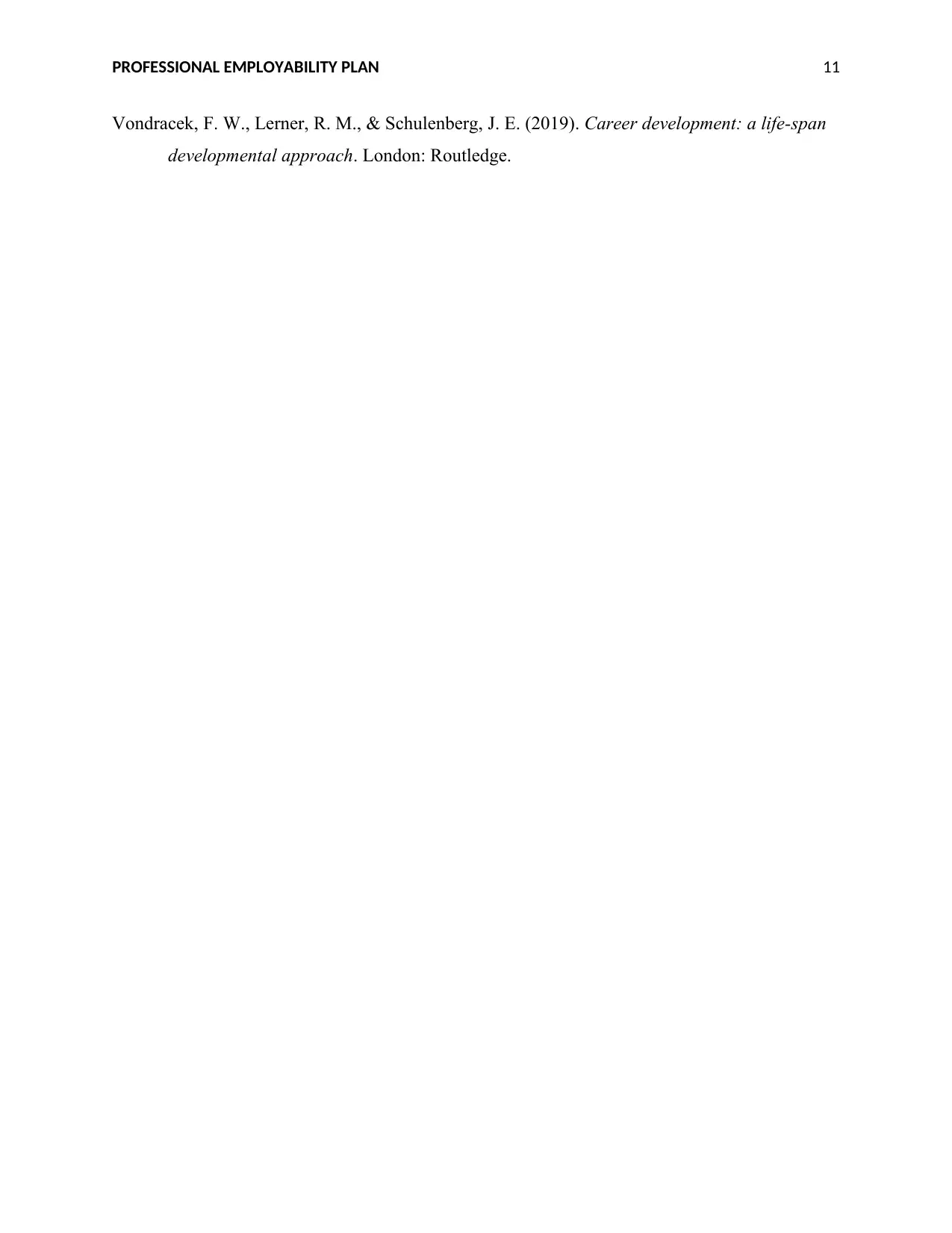
PROFESSIONAL EMPLOYABILITY PLAN 11
Vondracek, F. W., Lerner, R. M., & Schulenberg, J. E. (2019). Career development: a life-span
developmental approach. London: Routledge.
Vondracek, F. W., Lerner, R. M., & Schulenberg, J. E. (2019). Career development: a life-span
developmental approach. London: Routledge.
1 out of 11
Related Documents
Your All-in-One AI-Powered Toolkit for Academic Success.
+13062052269
info@desklib.com
Available 24*7 on WhatsApp / Email
![[object Object]](/_next/static/media/star-bottom.7253800d.svg)
Unlock your academic potential
Copyright © 2020–2025 A2Z Services. All Rights Reserved. Developed and managed by ZUCOL.





